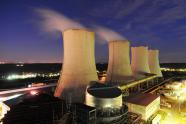Nuclear Waste Will Remain Buried Until 2012 Election is Decided

It’s likely that the issue of nuclear waste will
remain buried until well after the 2012 presidential
election. But if you listen to the General
Accountability Office, the matter shouldn’t sit for
too long.
Nuclear plant operators have funded both the studies
and the development of a permanent burial site for
spent fuel. But such a resting location has gotten
sidelined. Some would say that it is for political
reasons. Others would say it is for geological
reasons. Either way, the goal should be to find a
home for the roughly 70,000 metric tons of
radioactive nuclear material that is now sitting
on-site at specific nuclear generators, according to
the
congressional watchdog agency.
That’s because it will take decades to build a
permanent storage spot and then to transport such
used fuels there, it adds, noting that the spent
fuel stored at commercial reactors is growing at
2,000 metric tons per year. The agency says that one
of the biggest concerns it has is the generational
transference of vital information, which includes
where the current waste is stored and how to safely
move that used fuel.
Therefore, the Nuclear Regulatory Agency should
“develop a mechanism that allows individuals with
appropriate clearances and the need to know to
easily identify and access classified studies so as
to help insure that institutional knowledge is not
lost,” says the watchdog agency.
At present, 120 nuclear waste storage facilities
exist in 39 states. About three-quarters of the used
nuclear fuel is in “spent fuel pools” while a
quarter is above-ground steel-encased dry casks. The
risk with respect to the “wet” storage is centered
on what happened at Japan’s Fukushima plant, which
is that the auxiliary power would fail and the pools
would dry up. Fires could then ensue and there would
be a risk of radiation spreading.
Transferring the spent fuel from wet to dry storage
offers several benefits, the agency says. The waste
could be stored for decades longer, or at least
until a permanent repository is found. That would
also reduce the risk of “pool fires” and the spread
of radiation. It adds that moving the fuel from
spent fuel pools to the dry casks is safe and that
it should be “accelerated.”
“The chances of a radiation release are extremely
low in either wet or dry storage, but the event with
the most serious consequences -- a self-sustaining
fire in a spent fuel pool -- could result in
widespread radioactive contamination,” the agency
says. The NRC, generally agrees, adding that it it
considers both types of on-site storage to be safe
and that any decision to transfer comes down to each
utility’s own “cost-benefit” analysis.
Court Action
That choice of wet or dry storage is getting more
complex. That’s because a federal appeals court
ruled recently that the NRC failed to do its job
when it previously told nuclear operators that they
could extend their onsite storage from 30 to 60
years. The U.S. Court of Appeals in the District of
Columbia ruled that the nuclear regulators did not
properly examine the environmental consequences of
its actions.
The nuclear industry says that the decision is a
set-back -- but that it is not fatal. It will work
with the NRC to satisfy all obligations under the
law. Long run, though, it maintains that a permanent
storage facility is necessary. In fact, it is trying
to resurrect Yucca Mountain, which the Obama
administration de-funded in 2009. Utilities have
filed suit demanding that the site go forth and the
same D.C. Appeals Court will decide the outcome,
perhaps soon.
“The federal government used funds from nuclear
plants to create the Yucca Mountain permanent
storage site in Nevada, but this project is now on
hold,” says
Exelon Corp., which is the nation’s largest
nuclear owner and operator. “Until the federal
government determines a new solution, Exelon safely
stores its spent fuel in plant spent fuel pools or
dry casks consistent with federal regulations.”
The Obama administration has argued the engineering
risks associated with Yucca Mountain are too great
-- that ground water could seep into where the spent
fuel rods would be stored. But others are saying
that the motives are purely political, pointing out
that the president was trying to appease Nevada’s
voters as well as the then-Senate Majority Leader.
A high-powered
blue ribbon panel issued its findings earlier
this year, saying that such decisions ought to be
taken out of the political arena and be given
instead to an independent organization that is
empowered to succeed. It also says that some interim
storage facilities could be consolidated, or that
multiple, fresh sites could house the spent fuel.
The issue is unlikely to sway the November
elections. But the federal court’s eventual actions
will force the various stakeholders to make their
next move.
EnergyBiz Insider has been awarded the Gold for
Original Web Commentary presented by the American
Society of Business Press Editors. The column is
also the Winner of the 2011 Online Column category
awarded by Media Industry News, MIN. Ken Silverstein
has been named one of the Top Economics Journalists
by Wall Street Economists.
Twitter: @Ken_Silverstein
energybizinsider@energycentral.com
Copyright © 1996-2012 by CyberTech, Inc. All rights reserved.
To subscribe or visit go to: http://www.energycentral.com
To subscribe or visit go to: http://www.energybiz.com